|
Memories of a Legend:
Ethan Wayne Remembers His Dad, John Wayne
Interview by Hector Cantú
Posted May 2012
Editor’s note: On Oct. 6-7, 2011, Heritage Auctions sold more than 700 items from the John Wayne Estate for $5.39+ million. The following interview with Ethan Wayne, the youngest son of John Wayne (he played “Little Jake McCandles” with his father in the movie Big Jake, 1971), was published before the auction in Heritage Magazine for the Intelligent Collector and is reprinted here with permission. The interview provides wonderful insights into John Wayne as a celebrity collector and as an American icon.
-----------------
While managing John Wayne Enterprises, Ethan Wayne and brother Patrick have fielded thousands of phone calls from fans, all requesting the same thing.
“Almost daily phone calls,” Ethan says in astonishment. “People asking, ‘Can I get this from this movie? Can I get that from that movie? Can I get a belt? Can I get a vest? My mother’s a huge fan. My son watches John Wayne movies all the time. Can we get something?’ And we’ve always had to say no.”
Now, that’s about to change.
In October, Heritage Auctions is offering the Personal Property of John Wayne, more than 700 items directly from The Duke’s estate. Included are costumes, clothing, scripts, awards, and personal items and documents. “Finally, for the first time, when people call, I can say, ‘You know what? You can get it now and it’s going to be available to everyone,’ ” Ethan says. “This auction is for the people, the fans.”
Few Americans have impacted American culture like John Wayne. The native of Iowa, born Marion Robert Morrison, is considered the most popular actor in history, ranking among the top 10 box-office attractions for 25 consecutive years. Born to Wayne and his third wife, Pilar Pallete, Ethan was 17 when his father passed away. He’s worked in films himself, appearing with his dad in the 1971 western Big Jake and later doing stunt work in The Blues Brothers and acting in TV’s The Bold and the Beautiful and The New Adam-12.
Today, Ethan Wayne, 49, manages John Wayne Enterprises, which protects the actor's legacy. He is also director of the John Wayne Cancer Foundation, which raises money to support cancer research, education and awareness.
Ethan says the time is right for the auction.
“I talk to people who say, ‘I bought the sign from the bar in The Quiet Man. I’ve got it in my house!’ People want these items, and these pieces have never been available before,” Ethan says. “For John Wayne fans, this is a treasure trove. I mean, we have his 1929 prop card … the name says ‘Duke Morrison.’ This is from before he had an acting career. He had that in his dresser drawer. These are things he kept since 1929! It’s a great collection and I think people are going to be very pleased.”
Heritage Magazine talked to Ethan at his home in Newport Beach, Calif., the town where his father lived after leaving Los Angeles until his death from cancer in 1979.
I see that your dad had minerals and rocks. So John Wayne was a collector?
He loved mining. He loved minerals and rocks. You’ll see an extensive collection in the auction. He also collected Kachina dolls. Those are now in the National Cowboy & Western Heritage Museum in Oklahoma City. They built an entire room to house the collection. He loved those dolls. He liked miniature steam engines and trains. He was busy, so he couldn’t be a tinkerer because he just didn’t have the time, but he enjoyed things.
You were a young boy near the end of your father’s movie career. What’s the earliest film you recall seeing and what was your reaction to it?
That is a great question, and I don’t have a great answer for it. We had a theater in the house, and we screened not only his movies at least weekly, but all the new movies that came out. He kept his finger on the pulse of what was going on in Hollywood.
You were on the set quite a bit with your dad.
For my dad, it was probably a pain in the neck to have me around at times because kids want to get into everything. On the one hand, he’d yell at you for getting into it, but on the other, he liked the fact that you were a kid with a sense of adventure.
True Grit came out when you were only 7 or 8. What do you remember about that movie?
I recall pretty clearly being on the set in Colorado because it was such a beautiful place and so different from Durango, Mexico, where we spent a lot of time. There was Ned Pepper’s shack down by the hot springs. It was really steep to get from where the trailers were down to the set. You had to actually go down this rope, down a trail. And I can remember just constantly climbing up and down that thing. That is not my first recollection, but my first real strong recollection of being enamored with being on location, not so much the movie set but just being out there with the wranglers and the stuntmen and my dad and some of the other more rough-around-the-edges actors who were around. A lot of tough old guys. It was fun being around them. They had that pit with the snakes, so I was always trying to go in that pit, and they would yell, “Get out of there!” I’d go away, then sneak back!
Any other movie memories?
I have good memories of being in Durango, where they had a western street built with the facades that they could use for different films. And they actually had a length of railroad, an old steam engine they could operate and bring into town. When I was 8, we made Big Jake there, and I was there for the entire production. That’s a pretty fond memory. My brother Michael produced it. My other brother Patrick was in it. Maureen O’Hara was in it. Richard Boone was in it. Bruce Cabot was in it. That was an age where I could ride my own horse. I was allowed a fair amount of freedom. I remember I rode my horse one day and left the set and went to our house or into town and came back, and my dad asked, “Where the hell have you been?” You remember stuff like that. He’d say, “Well, I’ll be damned. Hey, Chuck, this kid just rode into town!”
How did your dad approach his work? He had standards and expectations for how his persona was portrayed, correct?
He had very specific ideas about what the public wanted to see and what type of characters he wanted to play. He would never play a character that was mean or small or petty. I can’t say he wouldn’t play one that was ruthless. He would play one that was flawed, but he wouldn’t be small or petty. He could be conflicted; he could be not perfect, but he wouldn’t be small or petty.
There are several costumes in the auction from movies such as Chisum, Big Jake, The Shootist, War Wagon. Why do you think your father kept these?
If you look at his films, his early films, he looked like the other movie cowboys, like Gene Autry or Roy Rogers. They all had a similar style, but as he became seasoned, as his own career evolved, he became more economical in the embellishments of his performance and his wardrobe. The wardrobe was a tool of his trade. His gun belt, his guns, the bullets, the way he wore it, the positioning of the rounds in the belt. There was a reason for everything. It’s how a carpenter wears his belt a certain way because that’s how he works. All his clothing, once he found things he liked, he kept them. He’d also do things where he needed the wardrobe handy in Newport Beach because he wasn’t in Los Angeles anymore. He kept a lot of those items with him. Then later, [John Wayne Enterprises] went to Western Costume Company and bought out their entire collection of Wayne wardrobe.
He also kept scripts from his films. The auction features virtually all the movies he did in the last 15, 20 years of his life.
I don’t know the exact reason why he kept them, but he put a lot of himself into his characters. There was a lot of thought put into how he portrayed this American man, this American cowboy, and so I think he kept them because there was a little piece of him in every script. I’d lay in bed with him in Durango, or wherever we were, and he spent hours at night with his scripts. We’d have dinner, and he’d be looking at that script. He’d work very carefully to make sure he could get his point across, oddly enough, in as few words as possible, as opposed to trying to get more dialog. You’d see people fight for dialog, and he’d say, “Take it.” He and [director] John Ford would work out ways to say the most with the fewest words.
And he didn’t hesitate to rewrite lines for himself or offer suggestions.
Not at all. He didn’t brush the writer or director or anyone else aside, but he certainly knew what he was doing by the time I was born, and it was an integral part of the production process.
What about your dad’s awards? Which did he covet the most?
He was very fond of the People’s Choice Awards. As a young boy, he would say to me, “Those are the ones that really mean something. They are from the people who watch my movies. They are the ones who allow me to keep doing this and allow me to live my life and provide for my family.” I remember being at the Academy Awards when he won, and I look back at photos now, and he’s talking to people, my mother’s talking to people, and I’m holding the Academy Award with one hand down by my side or aiming it like a rifle. I was nine, so I remember as a kid when he handed it to me thinking, “Geez, this thing’s heavy!” I thought it was strange that he would allow a nine year old to run around with his Academy Award because that award did mean a lot to him, obviously. He gave me a lot of trust as a kid.
Where did he keep the awards in the house?
The den was a large room and one whole wall was for the awards, the recognitions that were important to him, photos of friends and items that were important to him, as well as his gun collection.
What about family life? Was there a sense that you were doing things not too many kids your age were doing?
Not to me. One of the first times I realized things were a little different was when I was at a sleepover at a friend’s house, and his mother told us to go get the mail. And I thought, “Oh, crap!” Because at my house, getting the mail involved carrying bags and boxes in from the street. We went up to his mailbox, and there were two or three envelopes. I was astounded that that was all the mail they got. In my mind I was thinking, “Wow, we get a lot more mail than that.”
Most of this was fan mail?
Well, my dad was a catalog shopper, and he loved to circle items in catalogs and order them: trinkets, mini cameras, knife sets, just stuff. He loved the catalogs. We had boxes coming all the time. Some of those catalogs are in the auction, and it’s pretty cool because here, some 30-odd years later, we have the catalog, the item circled, we have the item he ordered, we have the receipts, and the checks and the boxes they were shipped in. One was a brass duck head that was also a paperclip. The beak clipped on to the papers. You really get a picture of my dad sitting there thinking, “Oh, I wanna get this duck paper clip.”
That sounds like a lot of average fathers.
My father was not pretentious at all. We didn’t travel with bodyguards. He personally answered the door. He answered the phone. We lived in a normal neighborhood. My friend lived three doors down. His mother was a single mom who was a dental hygienist, right there in the same neighborhood. As a child, I never felt any sense of entitlement. I felt like a normal kid. If I didn’t do my chores, I’d get in trouble. I loved hanging out with my pals. Looking back now, I’m shocked at how much freedom I had as a young boy, and that’s a testament to my father. He was a real man and a regular guy.
What are your fondest memories of your dad?
I connected with my father pretty well when I was a young boy. I was crazy for my dad. He felt like home to me. I don’t know how you describe that feeling. I can remember when he’d leave. From my room, I could see him walk out to the gate, and I knew he was going away for a long time, and I’d be devastated. He’d always say, “All right boy, see ya in October,” or whatever it was, and he’d say, “God willing and the river don’t rise.” I got this horrible feeling inside! My stomach would drop every time he’d say it. “Why’d you have to say that?” And he’d hit the gate, and I’d see him leave, and I’d think, “Don’t go! Oh my God! What does that mean? ‘God willing and the river don’t rise.’ ” I just didn’t get it.
He’d come home, and I’d jump up, and he’d lift me up in the air and give me a big hug and a kiss.
What kinds of things did you guys do together?
We did guy things. It was always exploring, fishing, hiking, boating. We were always outdoors. I think he was happiest when he was on location, which for a kid was like going on an adventure because you’re going to Mexico, Colorado, New Mexico, sort of ranchy places where there were horses, and I could drive a car or a motorcycle. I had tons of freedom. If you split up his life, it would be 30% at home, 30% on his boat, and 30% was probably on location.
He spent a lot of time on his boat, the Wild Goose. How important was that boat to him?
It was an island for him, a sanctuary, a place where he would be relaxed and comfortable with his friends. We might go from Seattle to Desolation Sound in British Columbia, then head up to southern Alaska. In the wintertime, we’d go down to Mexico, Cabo San Lucas and La Paz in the Sea of Cortez and work our way down to Manzanillo, just wherever they felt like going. I was in heaven. I remember we’d be underway, it might be night. He’d pick me up and sit me on the railing. If I clung to him, he’d say, “What do you think I’m going to do? Drop you? Lean back!” So I’d lean back over the ocean in the middle of the night while he’s holding my arms and relax. And he’d say “See! I’m not gonna let you go!”
So lots of fond memories from those trips?
These were big boats. His boat was 136 feet and his friend’s boat was 100 and something feet. One day, I said I wanted to go to the other boat for their pancakes. [The friend] had a French woman who cooked for him, and she made these great pancakes. My dad says, “Oh, you want the pancakes?” He got on the radio and said, “Max, get the boat over,” and they got the boats going side by side underway, and he took me and threw me over to the other boat. I’m 8! It was great, [throwing] your kid from one boat to another, in the open ocean, with a 10-foot gap between the boats! It was just a different life then.
You were a teen when your father died. How did that impact you?
I was 17. I lived with my father. My parents separated but never divorced. They kept a cordial relationship. We were free to go back and forth. I stayed with my dad a lot when he was sick. He came in one night and said, “You need to take me to the hospital.” So I loaded him into the station wagon and drove him to UCLA, and he ended up never coming out of there. I didn’t really understand what was going on. I knew he was sick, but he’d never not come out of the hospital.
How did things change after that?
The house was kind of locked down the day he died. I was allowed to go in and take a few items, as was the whole family, but then everything else was put into storage. Thirty years later, when I took over [John Wayne Enterprises], we realized we had to do something with it because over time, it would deteriorate if kept that way. Luckily, it’s all in great shape.
There are numerous books in the auction. Your dad read a lot.
He was an avid reader. He read voraciously. If he wasn’t reading a script, he was reading a novel, and he’d communicate with the authors or other actors about stories and how he felt about them, how he felt about the author. He read everything. He loved American history and loved stories about people. He wanted to find those stories. His life was about telling stories.
And despite his busy life, he found the time to write letters.
He spent an inordinate amount of time communicating. He liked interacting with people. I can remember a number of times when I was a little boy, I’d be scared because someone was coming up the dock, and he would grab a gun and head outside. We kept guns in the house, all loaded. He’d go outside. I’d be behind him, and there’d be a couple of guys trying to get the courage to come up the plank to talk to John Wayne. He’d say, “Who the hell are you? What are you doing on my dock?”
“Oh, gee, John Wayne, sorry sir, we’re Marines. We knew you lived here. We wanted to see if you were home.” He’d say, “Well, get up here and have a drink with me!” He’d sit down and talk to ’em until one o’clock in the morning and then send them on their way. He cared about people. I can remember looking at him and thinking, “Who are these people, and what are they doing in our house?” I didn’t understand as a boy that he was taking care of them.
How did your father inspire you and your siblings?
He was a great guy, a great man, a wonderful person and anyone who interacted with him respected him. People may disagree with his ideas or politics, but they all respected him and really liked him. You’ll see some interviews with people who are on the other side of the spectrum politically or personally, and after they spend time with him, they’ll say, “We had a great time with him. He’s a wonderful man, a great person to know.” He got stereotyped, especially as he got older, but if you were face to face with him, he was a real and personable man. And if he felt strongly about something, it was typically for a reason, and that reason came from experience.
So what’s keeping you busy these days and how did your father influence that?
Today, I run John Wayne Enterprises, which he sold to his seven children before he died. We oversee all merchandising and advertising in his name. I’m also the director of the John Wayne Cancer Foundation (www.jwcf.org), an organization which brings courage, strength and grit to the fight against cancer by supporting research, education, awareness and support. My dad influences me in the Enterprises because when I look at a product or program, I work to make sure that we incorporate his spirit into that product. If it’s a mug, it’s a great mug. If it’s a pocketknife, it’s a terrific pocketknife. Something that can be used and enjoyed. As far as the Foundation goes, my father had the ability to affect people viscerally and emotionally. He could inspire them to overcome. At the Foundation, we support research and education, but also awareness and support groups that help people deal with their cancer. And John Wayne can inspire them to remember who they were before cancer, to take charge of their lives again, and move forward. The support groups that we underwrite get people outside into the elements, whether it be fly-fishing, river rafting, rock climbing or standup surfing. We want them out there in nature having an adventure in John Wayne country.
Why is this auction happening now?
I get phone calls almost daily from people wanting items, and the answer has always been the same—no. Items are not available. But the way I look at it, everybody’s covered. He left a lot of art and memorabilia to the National Cowboy & Western Heritage Museum in Oklahoma City. There are other museums that have collections of his art and memorabilia, like the Autry in Los Angeles. The family has had a chance to select items that are important to them, and we retain a core collection for John Wayne Enterprises for historical and reference purposes. It’s finally time to say to the fans, “Yes, you can get something for yourself or a loved one.” I think this auction will be very personal for a lot of people. They feel a very personal connection with John Wayne.
What message do you want to send with this auction?
This is for the fans. If you were in my office you’d hear the stories. “This is John from Oklahoma. My father, my son and I all get together every Christmas or Father’s Day and watch these three films. I would like to buy the scarf from this for my father. It would mean so much to him. When he was going through this in his life, he watched this film, and it helped him get through a crisis or tough time. It helped him make a decision. It gave him guidance and inspiration.” That’s what this auction is going to do. It’s going to allow the fan to get that piece from an experience that was important to them at a certain point in their life and left a lasting impression.
Where do you hope these items end up? What is the perfect home?
The perfect place is with people who appreciate them. These items are going to mean certain things to certain people. They’re going to be important to them. It may have helped them with a decision in their life. They watched a certain movie and they saw him go through something, that character go through something in that film, and it helped them make a right turn instead of a left turn in their life and that’s going to mean a tremendous amount to them.
Finally, what’s the legacy of your father? He came to symbolize, in many ways, the American man.
I think the ultimate legacy of my dad is how people feel about him in their hearts. If they can turn on a film and look at a character or how he portrayed the American man and gave inspiration to someone on how to lead their lives or make a decision or get through a tough time, I think that’s a pretty substantial legacy.
---------------------
Hector Cantú is editorial director at Heritage Magazine for the Intelligent Collector, where this story originally appeared. ©Heritage Auctioneers & Galleries Inc. Reprinted with permission.
|
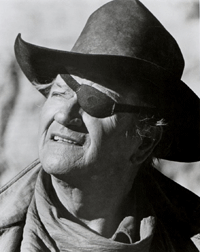
Eye patch from True Grit (1969), $47,800. (Photo: Heritage Auctions.)
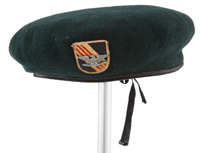
The top seller from the auction, a beret from The Green Berets, 1968,
$179,250, including 19.5% buyer’s premium. (Photo: Heritage Auctions; all prices include buyer’s premium.)
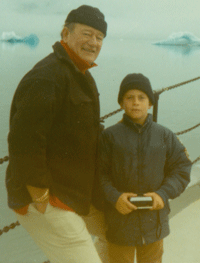
John Wayne and Ethan. (Photo: John Wayne Foundation.)
|
The John Wayne Auction’s
Top Lots
$179,250: Beret from The Green Berets, 1968.
$143,400: Golden Globe Award for True Grit, 1969.
$119,500: Cowboy hat from Big Jake, The Cowboys, and The Train Robbers."
$89,625: His last driver's license, issued by the State of California on May 12,
1977.
$77,675: Vest from Chisum, 1970.
$77,675: Andy Warhol Limited Edition Signed Print from the Cowboys and
Indians series.
$77,675: Nudie's cowboy hat from Rooster Cogburn, 1975.
$77,675: Holster and gun belt from El Dorado, 1966.
$71,700: Western saddle and stand, 1960s.
$71,700: Oil painting by John Decker, 1945.
$56,762: Oak desk, 1950s.
$56,762: People's Choice Award, 1976, for "Favorite Motion Picture Actor."
$47,800: Eye patch from True Grit,1969.
$44,812: Vest from Big Jake, 1971.
$44,812: Bib shirt from The Man Who Shot Liberty Valance, 1962.
$41,825 Cowboy hat from McLintock!, El Dorado, and The War Wagon.
$41,825: Stetson cowboy hat from The Man Who Shot Liberty Valance.
$41,825: Working script from The Searchers, 1956.
$41,825: Academy of Motion Picture Arts and Sciences Certificate of
Nomination for "True Grit," 1969.
$41,825: Andy Warhol Limited Edition Signed Print from the Cowboys and
Indians Series, 1986, titled, “Annie Oakley.”
|
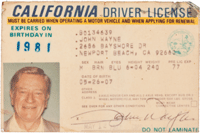
John Wayne’s last driver's license (1977), $89,625. (Photo: Heritage Auctions.)
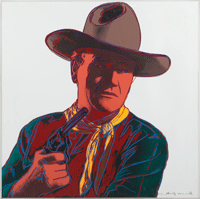
Andy Warhol limited edition, signed and numbered print from the “Cowboys and Indians” Series, 1986, titled “John Wayne,” framed: 36 x 36 inches, $77,675. (Photo: Heritage Auctions.)
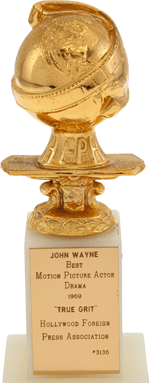
John Wayne’s Golden Globe Award for Best Actor in a Drama in True Grit, 1969; $143,400. (Photo: Heritage Auctions.)
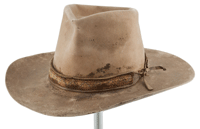
A cowboy hat worn in Big Jake (1971), The Cowboys (1972), and The Train Robbers (1973); estimated at $30,000-$40,000, it sold for $119,500. (Photo: Heritage Auctions.)
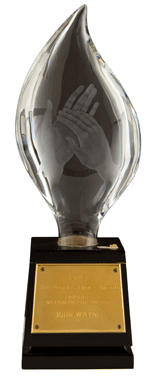
People's Choice Award (1976) for Favorite Motion Picture Actor, $56,762. This was one of John Wayne’s most treasured awards because it came directly from the fans. (Photo: Heritage Auctions.)
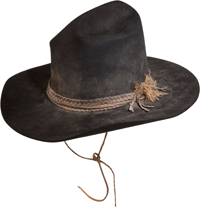
Cowboy hat from Rooster Cogburn (1975) by Nudie Cohn, $77,675. (Photo: Heritage Auctions.)
|
A DEFINING MOVIE
Stagecoach was John Wayne’s breakthrough movie, and today, it holds a special place in family history. “That film,” Ethan Wayne says, “changed my father’s life.”
Director Raoul Walsh cast Wayne in The Big Trail for his first starring role. The 1930 movie is considered the first big-budget outdoor spectacle of the sound era.
“He was 21, and he thought he was going to be a movie star,” Ethan says. “It was an epic film, a terrific film with a huge director, but the movie didn’t do well. He was friends with Walsh, and friends with [director] John Ford and Henry Fonda; all these guys making ‘A’ films. He socialized with them, but he couldn’t work until Ford put him in Stagecoach.”
The 1939 movie, which follows a group of strangers traveling through dangerous territory, was a financial and critical success, garnering seven Academy Award nominations and making Wayne a leading-man star.
|
|
HIS AWARD-WINNING ROLE
In 1969, John Wayne donned an eye patch to play the cantankerous U.S. marshal Rooster Cogburn. In a legendary movie moment, Wayne growls, puts his horse’s reins in his teeth, takes a rifle in one hand and a pistol in the other and charges the bad guys, barrels blazing.
The movie is a masterpiece, movie critic Roger Ebert has said, and it belongs “…on the list with National Velvet and Robin Hood and The African Queen and Treasure of the Sierra Madre and Gunga Din.”
The role won Wayne a Golden Globe and his only Academy Award for Best Actor.
“Wow!” Wayne said upon accepting his Oscar. “If I’d known that, I’d have put that patch on 35 years earlier.”
More than 40 years later, one of the eye patches Wayne wore in True Grit is featured in the Heritage auction. The patch, in fact, had a fine wire mesh covering a cut-out hole, allowing Wayne to see through it. “It was difficult for him to ride with that patch, so they made a patch he could see through,” Ethan Wayne says. “He was more comfortable during his 14-hour workday.”
Wayne reprised his role in the 1975 sequel, Rooster Cogburn.
|
|